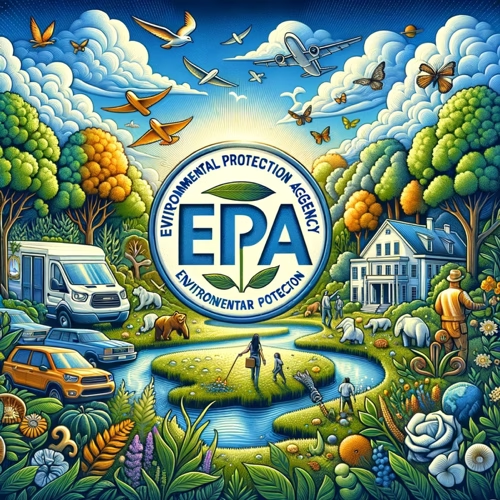Bra podd
Sveriges mest populära poddar

Environmental Protection Agency (EPA) News
EPA's Biggest Deregulatory Push: Shifting Power to States and Slashing Funding
3 min • 11 juni 2025
This week’s top Environmental Protection Agency headline: Administrator Lee Zeldin announced what he described as the “biggest deregulatory action in U.S. history,” with the EPA set to initiate 31 major reforms aimed at rolling back regulations, particularly those implemented during the Obama and Biden administrations. Zeldin’s message was clear: these actions are designed to “reduce regulatory costs by trillions of dollars and lower the cost of living on American households, making it more affordable to purchase vehicles, heat homes, and operate businesses.” The agency says this effort will support President Trump’s economic agenda by “unleashing American energy,” reducing living costs, and shifting more decision-making back to the states.
What does this look like in practice? The EPA plans to reassess and potentially scale back a wide range of rules, including greenhouse gas emission limits on power plants—the so-called Clean Power Plan 2.0—as well as methane, mercury, and water pollution standards for the energy sector. Other affected areas include reporting requirements for greenhouse gases and safety rules for chemical facilities. The focus, according to Zeldin, is to “advance cooperative federalism,” giving states more authority to regulate environmental issues locally.
However, these moves come as the agency’s own future is facing uncertainty. The EPA has proposed a budget for fiscal year 2026 that would slash funding by more than half—from $9.14 billion this year to just over $4.16 billion if Congress approves the cuts. That’s a potential 54 percent reduction. This has drawn sharp criticism from seven former EPA leaders, who warned in an op-ed this week that such cuts would “gravely reduce the agency’s capacity” to fulfill its basic mission and called on lawmakers to fully restore funding.
Businesses and industry groups are closely watching these developments. Many see opportunities for cost savings and reduced compliance burdens. But environmental advocates and former EPA officials warn that rolling back protections—particularly as the EPA moves to rescind drinking water limits on four so-called “forever chemicals”—could threaten public health and environmental safety.
State and local governments could see both more flexibility and, some fear, more responsibility and costs as regulatory authority shifts their way. Internationally, the U.S. risks criticism, as these moves could be seen as stepping back from climate commitments and environmental leadership.
What’s next? The EPA will be opening public comment periods for many of these proposed rule changes over the coming weeks. Citizens, business owners, and local leaders are encouraged to review the proposed changes, attend public forums, and submit feedback directly to the EPA. Key deadlines and comment windows will be posted on the EPA’s official website.
To stay informed or get involved, visit epa.gov for the latest updates and ways to submit comments. The next few months will shape how environmental protection is governed across the country—so now is the time for your voice to be heard.
What does this look like in practice? The EPA plans to reassess and potentially scale back a wide range of rules, including greenhouse gas emission limits on power plants—the so-called Clean Power Plan 2.0—as well as methane, mercury, and water pollution standards for the energy sector. Other affected areas include reporting requirements for greenhouse gases and safety rules for chemical facilities. The focus, according to Zeldin, is to “advance cooperative federalism,” giving states more authority to regulate environmental issues locally.
However, these moves come as the agency’s own future is facing uncertainty. The EPA has proposed a budget for fiscal year 2026 that would slash funding by more than half—from $9.14 billion this year to just over $4.16 billion if Congress approves the cuts. That’s a potential 54 percent reduction. This has drawn sharp criticism from seven former EPA leaders, who warned in an op-ed this week that such cuts would “gravely reduce the agency’s capacity” to fulfill its basic mission and called on lawmakers to fully restore funding.
Businesses and industry groups are closely watching these developments. Many see opportunities for cost savings and reduced compliance burdens. But environmental advocates and former EPA officials warn that rolling back protections—particularly as the EPA moves to rescind drinking water limits on four so-called “forever chemicals”—could threaten public health and environmental safety.
State and local governments could see both more flexibility and, some fear, more responsibility and costs as regulatory authority shifts their way. Internationally, the U.S. risks criticism, as these moves could be seen as stepping back from climate commitments and environmental leadership.
What’s next? The EPA will be opening public comment periods for many of these proposed rule changes over the coming weeks. Citizens, business owners, and local leaders are encouraged to review the proposed changes, attend public forums, and submit feedback directly to the EPA. Key deadlines and comment windows will be posted on the EPA’s official website.
To stay informed or get involved, visit epa.gov for the latest updates and ways to submit comments. The next few months will shape how environmental protection is governed across the country—so now is the time for your voice to be heard.
Senaste avsnitt
00:00 -00:00